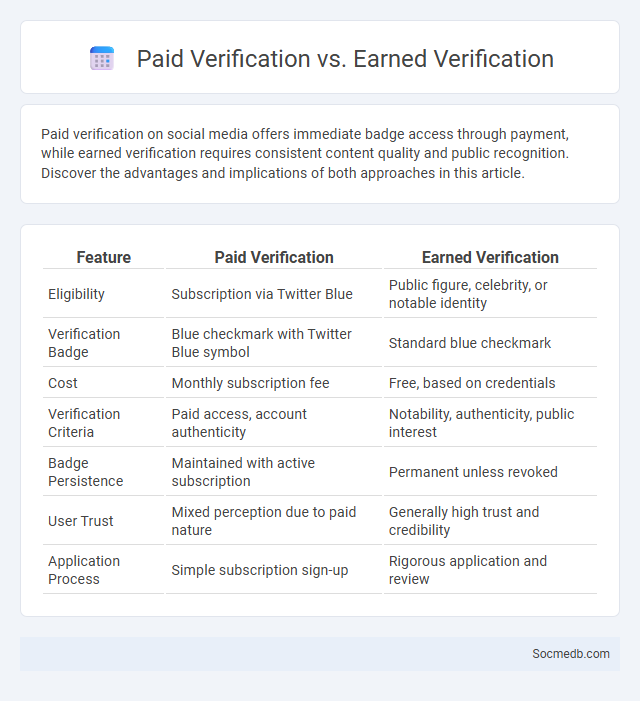
Photo illustration: Paid Verification vs Earned Verification
Paid verification on social media offers immediate badge access through payment, while earned verification requires consistent content quality and public recognition. Discover the advantages and implications of both approaches in this article.
Table of Comparison
| Feature | Paid Verification | Earned Verification |
|---|---|---|
| Eligibility | Subscription via Twitter Blue | Public figure, celebrity, or notable identity |
| Verification Badge | Blue checkmark with Twitter Blue symbol | Standard blue checkmark |
| Cost | Monthly subscription fee | Free, based on credentials |
| Verification Criteria | Paid access, account authenticity | Notability, authenticity, public interest |
| Badge Persistence | Maintained with active subscription | Permanent unless revoked |
| User Trust | Mixed perception due to paid nature | Generally high trust and credibility |
| Application Process | Simple subscription sign-up | Rigorous application and review |
Introduction to Verification: An Overview
Verification on social media establishes the authenticity of user profiles, ensuring users can distinguish genuine accounts from impersonators. Verified badges, commonly seen on platforms like Twitter, Instagram, and Facebook, provide credibility by confirming the account belongs to a public figure, brand, or organization. This process helps enhance trust and reduces misinformation within online communities.
What Is Paid Verification?
Paid verification on social media is a service where users can purchase a verified badge to authenticate their identity and increase credibility without undergoing the traditional vetting process. Platforms like Twitter and Instagram offer paid verification to help businesses, influencers, and public figures distinguish their accounts from impersonators and enhance trust with their audience. This feature often includes perks such as priority customer support and increased visibility in search results.
The Concept of Earned Verification
Earned verification on social media refers to the authentic credibility a user gains through consistent engagement, genuine content creation, and community trust rather than paid features. This form of verification highlights recognized influence and authority, differentiating it from purchased badges or automated verification processes. Platforms increasingly rely on earned verification to promote transparency and foster organic trust among users.
Understanding the Verified Badge
The verified badge on social media platforms such as Twitter, Instagram, and Facebook signifies an account's authenticity, typically belonging to public figures, celebrities, brands, or entities at risk of impersonation. This blue checkmark enhances credibility and trust, helping users distinguish genuine profiles from fake or fan accounts. Verification processes often require meeting specific criteria including identity confirmation, account activity, and adherence to platform policies.
Key Differences: Paid vs Earned Verification
Paid verification on social media involves users or brands purchasing a badge or status to enhance credibility, whereas earned verification is granted organically based on authenticity, notability, and public interest. Paid verification often provides immediate visibility and access to certain platform features, while earned verification requires meeting specific criteria such as account activity, follower count, and media presence. The key distinction lies in the legitimacy signal; earned verification is generally perceived as a more trusted endorsement by platforms like Twitter and Instagram.
Pros and Cons of Paid Verification
Paid verification on social media offers increased credibility and visibility, enhancing user trust and engagement by displaying a recognizable verification badge. However, it may lead to exclusivity, where lower-income users cannot afford verification, potentially undermining platform authenticity. Furthermore, paid verification can cause confusion between genuinely influential users and those simply willing to pay, affecting overall trust in the system.
Advantages and Drawbacks of Earned Verification
Earned verification on social media enhances credibility by showcasing authentic, user-generated recognition from reputable sources, boosting trust and engagement without paid endorsements. This organic validation increases visibility and attracts genuine followers, fostering stronger community connections and brand loyalty. However, the process can be time-consuming and inconsistent, leading to potential delays or denials that impact influencer growth and audience trust.
Impact of Verification Badges on User Trust
Verification badges on social media platforms significantly boost user trust by confirming the authenticity of profiles, reducing the risk of encountering fake accounts or misinformation. These badges enhance credibility, making your interactions with verified users more reliable and secure. As a result, verified accounts often experience increased engagement and stronger follower loyalty due to the perceived legitimacy conveyed by the badge.
Platform Policies on Verification Methods
Platform policies on verification methods enforce strict guidelines to ensure authenticity and security, requiring users to provide official identification documents or link verified accounts for access to verification badges. These policies help prevent impersonation and maintain trust across social media networks by systematically evaluating user credentials and activity. Ensuring your account meets these verification criteria enhances credibility and protects you from potential fraudulent activities.
Deciding Which Verification Method Is Right for You
Choosing the right social media verification method depends on your goals, audience, and platform requirements. Phone number, email, and two-factor authentication each offer different levels of security and ease of use, impacting how effectively you protect your account. Ensure your chosen verification method aligns with your security needs and provides seamless access to enhance your social media experience.
 socmedb.com
socmedb.com